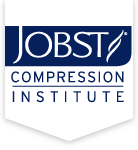JOBST® Compression Institute provides support and education for clinicians and healthcare providers treating patients with venous disorders. Understanding the statistics and facts about these disorders helps lead to increased awareness, diagnoses and management. And while widespread, venous disorders can be effectively and easily treated with compression therapy.
Learn More About Vein Disease
Most vein diseases are chronic conditions and can be associated with a wide range of health issues. They can impact anyone, but there are some risk factors that increase a patient’s likelihood for developing a vein disorder at some point during their life.
Risk Factors for Chronic Venous Disease
Chronic Venous Disease (CVD) occurs in the peripheral venous system of the legs. Venous valves, primarily in the calf, weaken over time and cause a blood to flow backward. This increases pressure on the peripheral venous system, leading to venous hypertension.
Patients with a history of deep vein thrombosis, varicose veins and other venous conditions have an increased risk for developing CVD. A family history of these disorders also increases a patient’s risk for CVD1. When left untreated, CVD can lead to Chronic Venous Insufficiency (CVI). Risk factors for CVD include:
- Being over the age of 50
- Being female
- Tall height
- Sedentary lifestyle
- Limited mobility
- Obesity
- Pregnancy
- A family history of varicose veins, venous ulcers or deep vein thrombosis
- Conditions like cardiac disease, diabetes, phlebitis, varicose veins, venous thrombosis and venous obstruction
Chronic Venous Disease Facts
Between 60 and 80 percent of leg ulcers are related to the venous system2. Additionally, CVI impacts nearly five percent of adults in developed nations3, while varicose veins affect as much as 30 percent of the population1.
1. Eberhardt RT, Raffetto JD. Chronic venous insufficiency. Circulation. 2014; 130(4):333-46
2. Nicolaides AN. Investigation of chronic venous insufficiency. A consensus statement. Circulation 2014; 102(20):e126-63
3. Angiology, 1997 Jan;48(1):67-9. Socioeconomic impact of chronic venous insufficiency and leg ulcers. Ruckley CV
Deep Vein Thrombosis
Deep Vein Thrombosis, also called DVT, occurs when blood clots form in the extremities. Clots that form in the legs can travel to the lungs, leading to a pulmonary embolism which can be fatal. Risk factors for developing DVT include:
- Blood-clotting disorders
- Prolonged periods of inactivity
- Pregnancy
- Cancer
- Heart disease
- Smoking
- Age
Post-Thrombotic Syndrome
Commonly referred to PTS, post-thrombotic syndrome can develop after periods of DVT. It is a chronic condition that can lead to permanent disability. PTS leads to more than 2 million lost work days each year.
PTS occurs after the body’s veins have been damaged by DVT, eventually leading to decreased blood flow to the damaged area. This can cause edema, pain and sores.
Deep Vein thrombosis is a serious healthcare problem in the US, with over 250,000 patients affected each year.
Source: Gloviezki, Peter, ed. The Layman's Handbook of Venous Disorders. N.p.: American Venous Forum



